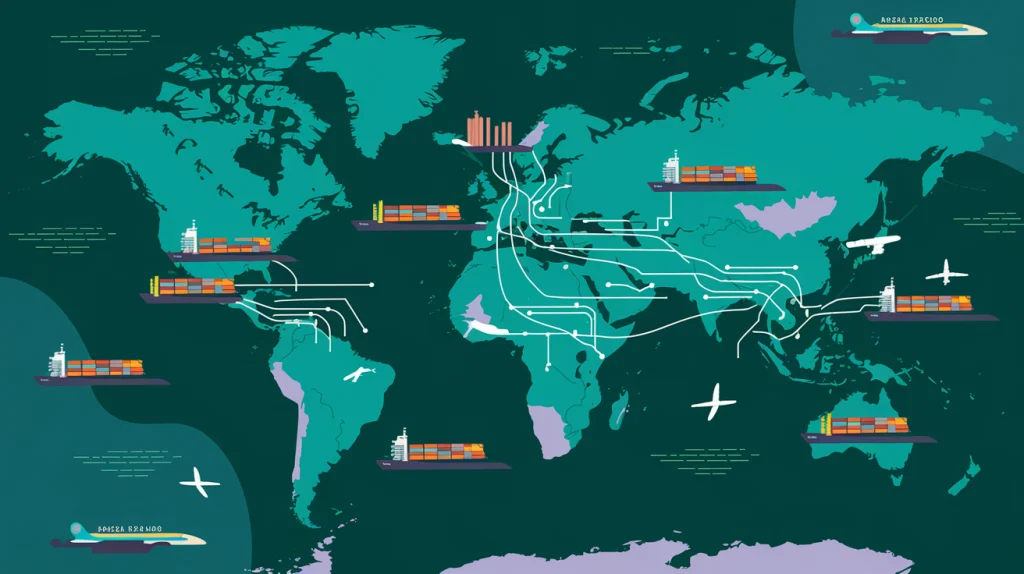10 Common Mistakes to Avoid When Shipping to Amazon FBA
On the surface, sending products to Amazon’s fulfillment centers might seem straightforward: pack your goods, label them, and ship. However, there’s a maze of requirements lurking beneath this simple checklist – from packaging and labeling protocols to rigid compliance rules. Oversights can be costly, leading to shipping delays, rejected inventory, added fees, or even account suspension.
In this blog post, we’ll cover the ten most common mistakes sellers make when shipping to Amazon FBA. By identifying and avoiding these pitfalls, you can streamline your supply chain, protect your Amazon seller account, and, most importantly, keep your customers happy.
Mistake 1: Choosing the Wrong Freight Forwarder
Many Amazon sellers, especially those just starting out, rely on their suppliers to handle shipping arrangements. While it might be convenient to let the supplier ship directly to Amazon’s warehouse, this approach has significant risks. Suppliers often lack specialized knowledge of Amazon FBA requirements and may ship the products incorrectly – leading to potential non-compliance, delayed deliveries, or unexpected additional costs.
Non-compliance with Amazon’s strict guidelines around delivery appointments, carton labeling, and packaging can create significant issues. Freight forwarders without specialized Amazon FBA knowledge may inadvertently violate these requirements, leading to potential complications. Delays are another risk, as missed delivery appointments or customs clearance hiccups can result in inventory stockouts, creating a ripple effect of lost sales and frustrated customers. Additionally, such errors often incur added costs, including re-labeling charges at the fulfillment center or unforeseen customs duties.
A reliable freight forwarder possesses several key features that ensure smooth and efficient shipping to Amazon FBA. Expertise in Amazon guidelines is paramount, as understanding delivery appointments and FBA preparation requirements helps avoid costly mistakes. Additionally, robust customs clearance management ensures that shipments move through international borders without unnecessary delays or complications. Timely deliveries and a commitment to preventing damage further establish a freight forwarder’s reliability. Moreover, choosing a logistics provider that offers comprehensive 3PL services and trucking to Amazon warehouses as part of an “All-in-One” solution can significantly streamline the shipping process, saving time and reducing errors.
How to Avoid
- Pick an Experienced Partner: Opt for a freight forwarder with proven expertise in Amazon-specific shipping protocols. Here’s a guide on how to choose the best freight forwarder to fit your business needs.
- Look for a “One-Stop-Shop”: Consider using a service like Unicargo, which offers end-to-end logistics solutions, from origin pickup to customs clearance to final-mile delivery at Amazon’s warehouse.
- Check for FBA Prep Services: Confirm whether your chosen partner can handle tasks like labeling, bundling, and packaging according to Amazon’s guidelines.
Mistake 2: Selecting the Incorrect Shipping Method
Choosing the wrong shipping method often stems from trying to minimize costs or from an unrealistic view of how quickly products need to reach Amazon’s fulfillment centers. FBA Sellers often opt for the least expensive ocean freight when a time-sensitive restock is actually needed, or they might overspend on express shipping for bulk inventory that doesn’t need to arrive overnight.
Misaligned delivery windows can pose significant risks to your operations. Choosing a shipping speed that does not align with your inventory needs may result in stockouts, which lead to lost sales and negatively impact customer satisfaction. On the other hand, if inventory arrives too early, you could incur high storage fees, unnecessarily inflating your costs.
Similarly, excessive shipping costs can also erode your margins. Opting for rapid shipping may seem like a solution but can become overly expensive, while slower, less costly methods might lead to delays and lost sales. Striking the right balance between cost and speed is essential for meeting your inventory demands effectively.
Air freight is an expensive yet fast option, making it ideal for urgent restocking. For larger shipments, ocean freight offers a more cost-effective solution, albeit with slower transit times. Planning your specific inventory requirements and weighing the trade-offs between cost and speed is key to selecting the most suitable shipping method.
How to Avoid
- Understand Your Restock Timeline: Review historical sales data, peak seasons, and supplier lead times to determine how fast your products really need to arrive.
- Compare Costs: Weigh the cost difference between air freight, ocean freight, and express shipping. Talk with your freight forwarder to identify the best solution to your specific needs.
- Use a Hybrid Strategy: In some cases, it may make sense to split shipments, sending a portion by air to cover immediate demand and the balance by ocean to save costs.
Mistake 3: Miscalculating Lead Times
In general, timelines are based on best-case scenarios – assuming production runs on schedule, customs clearance is immediate, and Amazon promptly checks in your inventory. The reality is that each stage can experience delays.
In reality, relying on overly optimistic timelines can lead to costly miscalculations. Delays in production, shipping, or Amazon check-in can disrupt your supply chain, causing missed sales opportunities or excess storage fees. Taking a proactive approach, such as building flexibility into your inventory strategy and accounting for potential disruptions, can further safeguard against unexpected challenges and maintain a steady flow of stock. Additionally, partnering with an experienced freight forwarder helps mitigate these risks by anticipating potential delays and ensuring smoother operations.
How to Avoid
- Build a Buffer: Factor potential delays into your calculations, whether it’s regional holidays or port congestion.
- Track Each Stage: Break down your timeline: production, shipping transit, customs clearance, last-mile delivery, and Amazon check-in.
- Use Projected Forecasts: Keep close tabs on your supplier’s typical production timelines and shipping partners’ transit times. Update your forecasts regularly.
Mistake 4: Ignoring Amazon’s Packaging and Labeling Rules
Amazon’s packaging and labeling requirements aren’t just guidelines – they’re mandatory rules. Not adhering to them can lead to inventory being rejected or delayed at Amazon’s fulfillment centers.
Incorrect Packaging
Sellers often lack familiarity with Amazon’s detailed packaging guidelines or attempt to cut corners to save on shipping costs. While using subpar packaging might reduce expenses initially, it frequently results in damaged goods or rejected shipments, ultimately costing much more. Poorly packaged items have a higher likelihood of arriving damaged, leading to negative reviews and increased return rates.
Additionally, Amazon may reject or repackage non-compliant shipments, leaving sellers responsible for any additional fees. Investing in proper packaging from the start ensures compliance, protects your products, and preserves your reputation.
Improper Labeling
Incorrect or missing FNSKUs, barcodes that aren’t scannable, or mixing SKUs in a single box can create major headaches at the fulfillment center. These labeling issues can lead to delayed check-ins, as Amazon will not process your inventory until all discrepancies are resolved. Additionally, sellers may face extra costs, such as re-labeling fees or the expense of having products returned. Ensuring compliance with Amazon’s labeling guidelines from the outset can save time, reduce costs, and maintain the flow of your supply chain.
How to Avoid
- Print and Verify Labels: Double-check that each item and carton has the correct FNSKU labels.
- Barcode Quality: Ensure barcodes are high-resolution and scannable – test them before shipping.
- Know Amazon Pallet Requirements: Adhering to Amazon’s pallet requirements to the letter is crucial for smooth processing at their fulfillment centers. Proper palletizing ensures efficient handling and minimizes the risk of delays or rejected shipments.
Mistake 5: Failing to Inspect Products Before Shipping
Cost-conscious sellers sometimes skip product inspections, assuming their suppliers have performed adequate quality checks. However, relying solely on the supplier’s word can lead to the shipment of defective or incorrect items.
Defective products can significantly harm your business, leading to increased return rates and a surge in negative reviews. Such outcomes not only affect customer trust but also trigger penalties from Amazon, which closely monitors defect rates. Consistently high defect rates can damage your account health and impact your ability to sell effectively on the platform.
How to Avoid
- Pre-Shipment Inspections: Conduct regular inspections – either by yourself if you’re local to the supplier, via a trusted third-party inspection service, or through a freight forwarder that offers inspection support.
- Create a Checklist: Verify product quantity, quality, labeling, and packaging compliance before shipping.
- Use Random Sampling: If it’s not feasible to inspect every product, do random checks or focus on SKUs with higher defect rates.
Mistake 6: Underestimating Shipping Costs
Sellers often focus on base freight costs alone and neglect the many hidden fees that can arise, such as customs duties, multiple warehouse fees, peak season surcharges, and more.
Unexpected shipping fees can have a significant impact on your business, quickly eroding profit margins and causing financial strain. Without adequate budgeting, unforeseen costs can strain your cash flow and disrupt operations. Planning ahead and allocating a sufficient budget for shipping expenses ensures smoother financial management and operational efficiency.
How to Avoid
- Get All-In Quotes: Request detailed cost breakdowns from freight forwarders and ask about potential extra fees (e.g., storage, demurrage, and customs exams).
- Factor in Seasonality: Be aware of peak seasons (like Q4 holiday rush) when freight rates and surcharges surge.
- Maintain a Healthy Margin: Always include a buffer in your product pricing to absorb unforeseen costs.
Mistake 7: Poor Inventory Management
Inventory management for Amazon FBA isn’t just about having the right amount of stock; it’s also about having full visibility and accurate demand forecasts.
Lack of Visibility
Many sellers rely solely on Amazon’s internal tracking or scattered spreadsheets. Without a centralized system, it’s challenging to track inventory from production to transit to the warehouse.
Misforecasting Demand
Sales forecasts that fail to consider historical trends, seasonal patterns, or the impact of marketing campaigns often lead to inaccurate demand predictions. Underestimating demand can quickly result in stockouts, causing a loss of valuable ranking and sales momentum. On the other hand, overestimating demand ties up capital in slow-moving inventory, leading to increased storage fees and the risk of obsolescence.
Accurately forecasting demand requires a balanced approach that takes into account past data, seasonality, and the potential effects of promotional activities, ensuring inventory levels are optimized to meet your customer needs while avoiding unnecessary costs.
How to Avoid
- Analyze Sales History: Look at last year’s sales data, factoring in any promotions or special events that might have skewed numbers.
- Adjust for Seasonality: Plan for spikes during holidays or key shopping events like Prime Day.
- Use Modern Tools: Unicargo’s digital freight forwarding platform provides you with the opportunity to make more informed decisions for inventory management and demand forecasting.
Mistake 8: Ignoring Regional Challenges and Seasonality
Global supply chains are riddled with potential slowdowns – from regional holiday shutdowns to peak season shipping congestion.
Regional Holidays (e.g., Chinese Blackout Days)
If you source products from regions with major holiday periods, such as Chinese New Year, it’s easy to overlook the production and shipping backlogs that can arise. During these holidays, factories typically close for extended periods, which can add weeks to your lead times.
Additionally, the rush leading up to these closures often pressures suppliers to prioritize speed over quality, leading to potential lapses in quality control. These factors can significantly disrupt your supply chain, causing delays and impacting the quality of your shipments.
How to Avoid
- Plan Ahead: Mark major holidays on your calendar and adjust production schedules accordingly.
- Maintain Open Communication: Stay in touch with your suppliers and freight forwarders about holiday schedules and potential delays.
Peak Season Shipping
During the holiday rush or promotional events, such as Prime Day, shipping rates often spike significantly, and carrier capacity becomes strained. These peak seasons bring challenges like skyrocketing costs due to surcharges, which can compress profit margins, and limited carrier space that risks delaying shipments if pre-booking arrangements are not secured. Managing these challenges effectively requires proactive planning, including securing carrier space in advance and building buffer stock to avoid last-minute premium rates or inventory stockouts.
How to Avoid
- Pre-Book Carrier Space: Partner with an experienced freight forwarder like Unicargo that can secure capacity during peak times.
- Build Buffer Stock: Ship well in advance of peak seasons to avoid premium rates and ensure you don’t stock out.
Mistake 9: Failing to Leverage Technology
Some sellers use manual spreadsheets for inventory management or rely solely on Amazon’s built-in tools. While these might work for smaller operations, they quickly become cumbersome as a business grows. Manual processes are more prone to human error, such as data entry mistakes, which can disrupt the entire supply chain. Additionally, without access to real-time data, sellers may struggle to react quickly to sudden changes in demand or shipping delays, further complicating their operations.
How to Avoid
- Adopt Software Tools: Look for solutions that automate tasks like demand forecasting, inventory tracking, and shipping documentation.
- Use Unified Platforms: Modern logistics providers offer integrated dashboards where you can book shipments, track cargo, and manage documentation – all in one place.
- Real-Time Alerts: Make sure your chosen system provides notifications about delays, stock levels, or any red flags that could impact your operations.
Mistake 10: Shipping Ineligible or Non-Compliant Items
Failure to carefully review Amazon’s restricted product list or adhere to regulatory requirements can lead to significant challenges when shipping products such as batteries, liquids, or hazmat items. Overlooking these rules increases the likelihood of non-compliance, which can severely disrupt your supply chain and customer satisfaction.
The risks of shipping non-compliant items are substantial. Amazon may reject entire shipments and impose return fees if even one restricted or improperly labeled product is identified. Repeated violations or severe infractions can escalate to account suspension or even permanent closure. Maintaining strict compliance with Amazon’s guidelines is essential to protect your operations and reputation.
How to Avoid
- Review Amazon’s Restricted Items List: Check the latest guidelines regularly; Amazon’s policies can change without much notice.
- Verify Product Condition: Ensure none of your goods are expired, damaged, or missing essential labeling (like product expiry dates or hazard labels).
- Consult an Expert: If you’re shipping any product that might be hazardous or regulated, speak with a freight forwarder experienced in specialized shipments.
Conclusion
Logistics is more than just moving goods from point A to point B. It’s about managing your supply chain strategically to optimize inventory levels, minimize costs, and deliver a superior customer experience. For Amazon FBA sellers, these ten errors represent just the tip of the iceberg. The reality is that successfully managing the complex world of FBA logistics requires not only attention to detail but also a trusted partner who can streamline operations and ensure compliance at every step.
Whether you’re new to the Amazon marketplace or a seasoned seller, partnering with an experienced logistics provider like Unicargo can make all the difference. With comprehensive services and a global reach, Unicargo simplifies the complexities of Amazon FBA shipping – from initial planning to final-mile delivery – allowing you to focus on growing your business with confidence and peace of mind.
Ready to streamline your Amazon FBA shipping?
Reach out to Unicargo today to discover how their tailored logistics solutions can help you avoid costly mistakes and take your operations to the next level.


